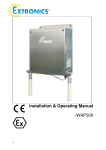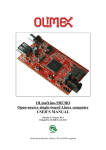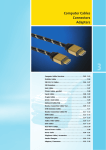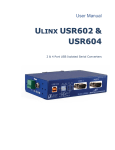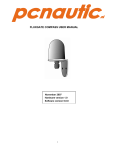Download Product Manual
Transcript
Operating Manual iWAP103 Operating Manual This page is intentionally left blank. Document Number 321282 (See Last Page for Revision Details) ©2006 Extronics Limited. This document is Copyright Extronics limited. Extronics reserve the right to change this manual and its contents without notice, the latest version applies. 2 Operating Manual Contents 1 2 3 4 5 6 7 8 Introduction.......................................................................................................... 4 Safety Information and Notes .............................................................................. 5 2.1 Storage of this Manual ................................................................................. 5 2.2 List of Notes ................................................................................................. 5 Installation and Setting-to-Work .......................................................................... 7 3.1 Installation .................................................................................................... 7 3.1.1 Removing the cover .............................................................................. 7 3.1.2 Fitting the cables ................................................................................... 8 3.1.3 Mains Power ....................................................................................... 11 3.1.4 POE/Ethernet Connection ................................................................... 11 3.1.5 Fibre Ethernet Input ............................................................................ 11 3.1.6 Earth Connection ................................................................................ 12 3.1.7 RS232/422/485 Wiring ........................................................................ 12 3.1.8 RS232/422/485 Dip Switch Configuration ........................................... 12 3.1.9 Thermostat Controls............................................................................ 14 3.1.10 Disassembly - Removing the PCB ...................................................... 16 3.1.11 Assembly – Fitting the PCB................................................................. 17 3.1.12 Fitting the 90° N-Type Connector................... ..................................... 18 3.1.13 Fitting the antenna mounting bracket .................................................. 23 3.1.14 Fitting the antennas to the bracket ...................................................... 25 3.1.15 General dimensions ............................................................................ 26 3.2 Setting to work............................................................................................ 27 Intended Purpose Usage................................................................................... 28 4.1 Transportation and Storage........................................................................ 28 4.2 Authorized Persons .................................................................................... 28 4.3 Cleaning and Maintenance......................................................................... 28 4.4 Safety Precautions ..................................................................................... 29 4.5 Cleaning and Maintenance Intervals .......................................................... 29 4.6 Aggressive substances and environments ................................................. 29 4.7 Exposure to external stresses .................................................................... 29 Technical Data .................................................................................................. 30 5.1 iWAP103 .................................................................................................... 30 Type Codes ....................................................................................................... 31 Certification ....................................................................................................... 32 Manual Revision ................................................................................................ 36 3 Operating Manual 1 Introduction The iWAP103 Zone 1 Universal Access Point Enclosure is designed to allow the deployment of wireless networks in hazardous areas. The concept allows installation of equipment from leading WLAN vendors including Aeroscout, Meru, Symbol, Cisco and Firetide. Each type of Access Point or RF transmitting device is rigorously checked and tested by Extronics and/or a Notified Body to ensure conformity to the ATEX requirements. This means that the user may select the vendor of their choice when extending a WLAN to hazardous areas. However equipment not already certified will require assessment to determine its suitability. To allow ease of installation to the end user the unit can be supplied via a 110/230VAC, or via IEEE802.3af POE providing the access point chosen is compatible. An optional POE supply module allows the iWAP103 to power up to two external devices such as IP cameras or additional access points. The iWAP103 has two RF outputs on N-type connectors allowing the connection of two antennas for dual radio access points. These antennas must be certified as Ex e increased safety devices (not included) such as the iANT100. Optional features include surge arrestors for lightning suppression in outdoor installations and fibre optic inputs for the Ethernet. Additionally the IWAP103 has optional single or dual RS232/RS485/RS422 inputs, allowing these interfaces to be transmitted over a WIFI link. The iWAP103 has the option of adding heating to the enclosure which can be used when the access point is required to be installed in temperatures as low as -20 oC. The heaters may be independently configured to shut off above set temperature thresholds. The protection board has two potentiometers fitted, which allow the user to set the temperature at which the heaters will switch off, and the temperature above which power to the access point is switched on. The default setting is to allow the user to select a temperature of between 0oC and 40 oC above which the heaters are off, and temperatures between -20 oC and 20 oC above which the access point turns on. Note: These temperatures can be altered on request when ordering. The iWAP103 is housed in an Ex d (Flameproof) enclosure rated to IP66, and is certified to; II 2 G EEx d IIC T5 Ta 55oC Max, T6/Ta 40oC Max Ex tD A21 IP66 T100oC@Ta55oC Max, T85oC@Ta40oC Max . 4 Operating Manual 2 Safety Information and Notes 2.1 Storage of this Manual Keep this user manual safe and in the vicinity of the device. All persons who have to work on or with the device should be advised on where the manual is stored. 2.2 List of Notes The notes supplied in this chapter provide information on the following. • Danger / Warning. o Possible hazard to life or health. • Caution o Possible damage to property. • Important o Possible damage to enclosure, device or associated equipment. • Information o Notes on the optimum use of the device Warning Installation only to be performed by skilled electricians and instructed personnel in accordance with national legislation, including the relevant standards and, where applicable, in accordance with IEC 79.17 on electrical apparatus for explosive atmospheres. Warning! The iWAP103 must not be operated in Gas Zone 0, or Dust Zone 20 hazardous areas. Refer to the specification for ATEX certificate information. Warning! Never open the enclosure in a hazardous area when the unit is energized, never operate the internal electronics without correctly fitting the lid and cable glands. Important The technical data indicated on the iWAP enclosure must be observed. Important Changes in the design and modifications to the equipment are not permitted. This includes changing the pre installed Access Point. Important The iWAP103 shall be operated as intended and only in undamaged condition. Important Only Ex e antennas which have been approved for use by Extronics may be used with iWAP103 Important Do not exceed the Effective Isotropic Radiated Power (EIRP) limit for the country/region of operation 5 Operating Manual Important Do not exceed the Effective Isotropic Radiated Power (EIRP) for the gas group in which the iWAP103 will be operating. The RF output of the transceiver will vary depending on the hardware and antenna used. IIC – 2W (+33dBm) IIB – 3.5W (+35.4dBm) IIC – 6W (+37.7dBm) Caution This assembly may weigh up to 15Kg depending on options fitted, therefore ensure the assembly is mounted using suitable fixtures. Caution When powering the iWAP103 via POE it is not recommended to also apply an external power supply to the protection board. 6 Operating Manual 3 Installation and Setting-to-Work 3.1 Installation The iWAP 103 is simple to install and can be secured directly to a suitable surface using the mounting holes on the Enclosure. Refer to 3.1.15 3.1.1 Removing the cover Warning! Never open the enclosure in a hazardous area when the unit is energized, never operate the internal electronics without correctly fitting the lid and cable glands. Unscrew the grub screw and remove the enclosure lid by turning it anti-clockwise. Grub Screw Figure 3.1 7 Four Mounting Lugs, 1 in each corner Operating Manual 3.1.2 Fitting the cables Depending on the configuration of the iWAP103, the connections for power and communication will need to be terminated into the enclosure via the cable entries shown in figure 3.2 (to be chosen by customer). Gland 1 M25 Gland 2 Gland 4 M20 M20 Gland 3 M25 Gland 5 M25 Figure 3.2 – Cable Gland Holes Cable glands are to be specified by the user when ordering, thread size is as indicated above while the thread pitch of all holes is 1.5mm. Depending on the configuration required these holes may be fitted with stopping plugs. IMPORTANT! All cables should be connected to the iWAP103 via a correct cable gland suited to the cable used, fitted by a competent person. Cable glands should be fitted in accordance with manufacturers instructions. See iANT100 manual for instructions on fitting iANT100 cable gland. IMPORTANT! Changes in the design and modifications to the equipment are not permitted. This includes changing the factory installed access point. 8 Operating Manual Optional POE Module see document 321313 for instructions if this option has been chosen Optional Fibre Module Connectors Not User Serviceable Surge Arrestor/Ntype. 2.4 Surge Arrestor/Ntype. 2.4 Surge Arrestor/Ntype. 5.8 Surge Arrestor/Ntype. 5.8 Thermostat potentiometers Dip Switches For RS232/422/ 485 configurations 5 RS232/485/422 Inputs (Optional) 4 3 2 Ethernet Input on Ethernet Earth screw plug/socket Input on Screw terminals RJ45 Connector 1 Mains Input on screw plug socket Figure 3.3 – iWAP103 Internal PCB View Important Only the input power connectors, DIP switches, Ethernet input connectors, thermostat controls and N-type/surge arrestors, as indicated in figure 3.3, are user configurable. Do not alter any other connections inside the enclosure. The access point must not be changed or the wiring altered. 9 Operating Manual Ref 1 Connector Pinout Description Mains Input 1 2 Pin 1 = Live Pin 2 = Earth Pin 3 = Neutral 3 Earth Screw Terminals 1 3 Ethernet input on RJ45 4 Ethernet input on screw terminals 5 RS232/422/485 Inputs 2 1 8 1 9 10 18 Both screw terminals are connected to earth, one of the terminals should be used to earth the enclosure, the other connector is a spare This RJ45 socket accepts a standard 8P8C plug for Ethernet connection Pin 1 = Tx + Pin 2 = Tx Pin 3 = Rx + Pin 4= POE in Pin 5= POE in Pin 6= Rx Pin 7 = POE + Pin 8 = POE in + Pin 1 = Tx + Pin 2 = Tx Pin 3 = Rx + Pin 4= POE in Pin 5= POE in Pin 6= Rx Pin 7 = POE + Pin 8 = POE in + Pins 1-9 are used for RS232/422/485 module 1 Pins 10-18 are used for RS232/422/485 module 2 See table 3.2 for connections depending on the configuration required Table 3.1 – Input Connector Pin Outs Power can be supplied to the access point via a mains supply or a POE supply. The POE supply is obtained directly from a POE enabled Ethernet input with the spare wires of an 8 pin input used for the power supply. Caution When powering the iWAP103 via POE it is not recommended to also apply an external power supply to the protection board. 10 Operating Manual 3.1.3 Mains Power To connect the mains power, feed in a suitable cable through a suitable cable gland. The PCB will be shipped with a socket fixed the PCB and a removable plug with screw terminals screwed into it (Ref 1). Remove the plug from the socket by unscrewing the screws at the two ends of the plug. Strip back the power cable and ensure suitable crimps are used for each core of the cable; the cables core must have a cross sectional area of at least 0.25mm2 and a maximum cross sectional area of 2.5mm2. Place the crimped wire into the correct screw terminal as indicated in table 3.1, and ensure the cable is securely screwed in place, then push the plug into the socket and securely screw the two together. 3.1.4 POE/Ethernet Connection Caution Only make one Ethernet/POE connection, i.e. do not make a connection to both the screw terminals and RJ45 connector! To power the unit via POE a suitable POE supply is needed along with the Ethernet input on (preferably) a cat-5 cable. The power is supplied on the spare pins of a standard 8-way twisted pair wire - on pins 4,5,7 and 8, with the other pins used for data transfer. The power can be supplied via the screw terminals (Ref 4) or the RJ45 connector (Ref 3) depending on the installer’s requirements and preferences. To power the access point via POE using the RJ45 connector (Ref 3) ensure that an 8P8C connector is wired as stated in table 3.1. Feed the cable through a suitable cable gland and then simply plug the cable into the socket and ensure the cable is securely fastened. To power the access point via POE using the screw terminals (Ref 4), feed the cable through a suitable cable gland. Remove the plug from the socket by unscrewing the screws at the two ends of the plug. Strip back the cable and ensure suitable crimps are used for each core of the cable; the cables core must have a cross sectional area of at least 0.14mm2 and a maximum cross sectional area of 1.5mm2. Place the crimped wire into the correct screw terminal as indicated in table 3.1, and ensure the cable is securely screwed in place, then push the plug into the socket and securely screw the two together. 3.1.5 Fibre Ethernet Input Important When connecting the access point via a fibre connection do not use the any of two Ethernet inputs of connectors Ref 3 or Ref 4. To obtain greater wired link distances the iWAP103 can be shipped with an optional fibre module. The fibre module will be connected directly to the access point, the user should attach the fibre cable directly to the fibre module using a multimode fibre cable on an ST connector. 11 Operating Manual 3.1.6 Earth Connection The earth screw terminals allow the user to connect the enclosure to earth, this would usually be done in the Extronics factory prior to shipping. There is also one spare earth terminal. To connect to this earth terminal strip back the cable and ensure suitable crimps are used; the cable’s core must have a cross sectional area of at least 0.25mm2 and a maximum cross sectional area of 2.5mm2. 3.1.7 RS232/422/485 Wiring If the optional RS232/422/485 module has been selected the serial input will need to be connected to the screw terminals correctly. The pin out wiring connections will depend on the interface you wish to use and is summarized below in table 3.2. To make a connection to for the serial interface feed the cable through a suitable cable gland. Remove the plug from the socket (Ref 5) by unscrewing the screws at the two ends of the plug Strip back the serial cable and ensure suitable crimps are used for each core of the cable; the cables core must have a cross sectional area of at least 0.14mm2 and a maximum cross sectional area of 1.5mm2. Pin (Module1/Module2) RS232 RS422/RS485 1/10 2/11 3/12 4/13 5/14 6/15 7/16 8/17 9/18 TxD DTR RTS RI CTS RxD GND DSR DCD TxD B + TxD A RTS B + RTS A RxD B + RxD A GND CTS B + CTS A - Table 3.2 Serial Pin Out Connections 3.1.8 RS232/422/485 Dip Switch Configuration To correctly configure the iWAP103’s optional serial interface the dip switches on the PCB need to be set correctly. Figure 3.x below shows an exploded view of the dip switches. Use table 3.3 to correctly set the dip switches for the serial interface required by the user. 12 Operating Manual S7 S6 S8 S5 S1 S4 S2 S3 Figure 3.4 – iWAP103 Dip Switch Connections Switch Description Mode Module1/Module2 S1/S5 Select clock timing S2/S6 Select RS232/422/485 mode S3/S7 Mode Select S4/S8 Line Termination 2.5ms 1=on 2=off 3=on 4.5ms 1=off 2=on 3=on 115/230Kbit/s mode 1=on 2=off 3=off RS232 mode 1=on 2=off 3=off 4=off 5=off 6=on R422 mode 1=on 2=off 3=off 5=off 6=on RS485 4-wire mode 1=on 2=off 3=off 5=off 6=on RS485 2-wire auto control mode 1=off 2=on 3=off 4=on 5=off 6=on RS485 2-wire DTR control mode 1=off 2=off 3=on 4=off 5=on 6=off RS232 mode 1=off 2=off 3 =off on 4=off RS485 2-wire mode 1=off 2=on 3=off 4=off RS485 4-wire mode 1=off 2=off 3=off 4=off RS422 mode 1=off 2=on 3=off 4=off RS232 mode All off RS485 2-wire mode All on RS485 4-wire mode All on RS422 mode All on 13 Operating Manual 3.1.9 Thermostat Controls Pot A Pot B Figure 3.5 – Thermostat Potentiometers If the optional heaters have been fitted, there are two potentiometers on the iWAP103 protection board which allow the user to alter the temperature set points. Pot A is used to set the access point switch on temperature, Pot B is used to control the heater turn off temperature If this option is fitted, the potentiometers will be factory set to; Pot A = -20°C (Fully Left) Pot B = 30°C (Fully Right) The potentiometers have a turn radius of 270o when the potentiometer is turned fully left the temperature will be set to a minimum. When the potentiometer is turned fully right, the temperature is set to its maximum By turning potentiometer A fully left the Access point will not turn on until the temperature reaches -20oC. By turning Pot A fully right the AP will not turn on until the temperature reaches 10oC By turning potentiometer B fully left the heaters will not turn off until the temperature reaches 0oC. By turning potentiometer B fully right the heaters will not turn off until the temperature reaches 30oC. 14 Operating Manual 15 Operating Manual 3.1.10 Disassembly - Removing the PCB Image Description Unscrew the enclosure lid. Unscrew and disconnect the RF connectors from the surge arrestors or bulkheads. Unplug all other connections to the PCB. Make note of the location of the connections you remove to aid reassembly Unscrew the 4 fixing screws from the spacers below 16 Operating Manual Tilt the front of the PCB upwards and pull towards you. Be careful when removing the PCB from the enclosure as the RF cables fitted under the PCB may get damaged. Be sure to take all necessary ESD precautions to avoid damaging sensitive components on the PCB Unscrew and disconnect the RF connectors from the surge arrestors or bulkheads on the under side of the PCB. Be careful not to bend the RF cables too tightly, especially by the connector, as this may damage the cable. Minimum bend radius of cable = 3.18mm 3.1.11 Assembly – Fitting the PCB To fit the PCB, follow the instructions found in section 3.1.10 of this manual in reverse order; • Connect RF connectors to surge arrestors or bulkheads on under side of the PCB • Carefully place the PCB inside the enclosure to sit on top of the spacers • Screw the 4 fixing screws through the mounting holes on the PCB to the spacers below • Fit all necessary connections • Screw in the enclosure lid securely 17 Operating Manual 3.1.12 Fitting the 90° N-Type Connector Image Description If using the Extronics iANT100 series of antenna’s, please follow the procedure for making the CR-UB-NP-16-M20 gland* as instructed in the iANT100 manual. If using another antenna, be sure to follow the manufacturer’s instruction as to fitting the cable gland. *CR-UB-NP-16-M20 is the recommended cable gland for use with the iANT100 antenna In order to fit an N-Type connector, cut off the connector and slide onto cable approximately 30mm of heat-shrink sleeving and the ferulle supplied with the connector. Strip the cable as shown leaving; • 8mm of exposed shielding • 7mm of exposed dielectric insulator • 4mm of exposed core 18 Operating Manual Using a soldering iron, tin the core of the cable Place the 90° N-Type connector on the end of the connector such that the dielectric and core sit inside the connector and the shield is outside of the connector Remove the cap from the top of the connector. Apply solder such that the centre pin of the connector and the core of the cable are bonded. 19 Operating Manual Slide the ferrule to the base of the N-Type connector and using the appropriate tooling, crimp the cable in place. Make sure that the cable and the connector are firmly secured. Universal frame crimp tool RS Stock No. 848-391 Universal frame die setRG58/59 cables RS Stock No. 848-436 Slide the sleeving to the base of the connector so that it covers the crimp. Apply heat to the sleeving until it has fully taken shape of the components it surrounds. Must be done in accordance to heat-shrink manufacturer’s instruction Re-fit cap to connector 20 Operating Manual Push the connector through the appropriate M25 cable entry on the iWAP103 enclosure. Be careful when doing this as not to damage the threads. Fit the connector to the NType bulkhead fitted to the PCB Thread the M25 to M20 reducer to the enclosure. Hand tighten and using a wrench, tighten by another quarter turn. 21 Operating Manual Fit entry body into the reducer previously fitted. Handtighten, then using a wrench tighten a further ½ turn Fit the remainder of the gland to the entry body using the union nut of the cable gland. Hand-tighten, then using a wrench tighten a further ½ turn Ensure all components are fitted securely 22 Operating Manual 3.1.13 Fitting the antenna mounting bracket Image Description Supplied fixings; 2 off M5 nyloc nut 2 off M5 x 16mm grub screw 2 off M5 plain washer 2 off M5 nylon washer Apply Loctite along the thread of the grub screw (243 – Thread lock or 270 stud lock) Using an allen key (2.5 ATF), thread the grub screws into the entries shown until they bottom 23 Operating Manual Once the grub screws are fitted, place the nylon washers onto the grub screws Place the antenna bracket (iANTMB02) onto the grub screws Using the plain washer and nyloc nut, fit the bracket securely 24 Operating Manual 3.1.14 Fitting the antennas to the bracket Image Description Fixing kit supplied with each antenna; 1 off M6 x 12mm pozi panhead screw 1 off M6 spring washer Using the screw and washer, fit the antenna to the bracket using the appropriate hole Tighten screws so the antennas are fitted securely 25 Operating Manual IMPORTANT! Only connect antenna cables to the N-Type or Surge Arrestor. Never connect the antennas to the access point directly. IMPORTANT! All cables should be connected to the iWAP103 via a correct cable gland, fitted by a competent person. IMPORTANT! Only Ex e antennas which have been approved for use by Extronics may be used with iWAP103 IMPORTANT! Do not exceed the Effective Isotropic Radiated Power (EIRP) for the country/region of operation IMPORTANT! Do not exceed the Effective Isotropic Radiated Power (EIRP) for gas group the iWAP103 will be operating in. The RF output of the transceiver will vary depending on the hardware used. IIC – 2W (+33dBm) IIB – 3.5W (+35.4dBm) IIC – 6W (+37.7dBm) 3.1.15 General dimensions 26 Operating Manual 3.2 Setting to work • • Once all cables are connected, refit the enclosure lid by rotating clockwise 700N/mm2, once the lid is closed ensure the grub screw is tightened. Refer to the original manufacturer’s instructions for detailed information on setting the hardware to work correctly in software. The RS232/422/485 com server uses a W&T 58631 device. Note! Ensure the lid is secure, correct cable glands are fitted and the unit device correctly wired and earthed for the particular application Note! Ensure that the threaded sections of the enclosure lid and body assembly are clean and undamaged. Also check the IP O’ring is clean and undamaged before fitting the lid. 27 Operating Manual 4 Intended Purpose Usage Important Before setting the units to work, read the technical documentation carefully. Important The latest version of the technical documentation or the corresponding technical supplements is valid in each case. The iWAP103 is built using modern components and is extremely reliable in operation; however it must only be used for its intended purpose. Please note that the intended purpose also includes compliance with the instructions issued by the manufacturer for installation, setting up and service. Any other use is regarded as conflicting with the intended purpose. The manufacturer is not liable for any subsequent damage resulting from such inadmissible use. The user bears the sole risk in such cases. 4.1 Transportation and Storage All iWAP103 devices must be so transported and stored that they are not subjected to any excessive mechanical stresses. 4.2 Authorized Persons Only persons trained for the purpose are authorized to handle the iWAP103; they must be familiar with the unit and must be aware of the regulation and provisions required for explosion protection as well as the relevant accident prevention regulations. 4.3 Cleaning and Maintenance The iWAP103 and all its components require no maintenance. All work on the iWAP103 by personnel who are not expressly qualified for such activities will cause the Ex approval and the guarantee to become void. 28 Operating Manual 4.4 Safety Precautions Important For the installation, maintenance and cleaning of the units, it is absolutely necessary to observe the applicable regulations and provisions concerned with explosion protection (EN 50014, EN 6007914:2003) as well as the Accident Prevention Regulations. 4.5 Cleaning and Maintenance Intervals The cleaning intervals depend on the environment where the system is installed. 4.6 Aggressive substances and environments The iWAP103 is not designed to come into contact with aggressive substances or environments, please be aware that additional protection may be required. 4.7 Exposure to external stresses The iWAP103 is not designed to be subjected to excessive stresses e.g. vibration, heat, impact. Additional protection is required to protect against these external stresses. The iWAP103 will require additional protection if it is installed in a location where it may be subjected to damage. 29 Operating Manual 5 Technical Data 5.1 iWAP103 Power Supply Universal 90-264VAC or IEEE802.11af POE Maximum Power Consumption Basic configuration 19W With RS485 modules 24W With POE output module 55W With heating 155W Enclosure Material LM6 marine grade alloy with epoxy paint coat Ingress Protection IP66 Weight Approx 15Kg, hardware dependent Dimensions 300 x 280 x 200 mm (w x h x d) Environmental Ambient temperature (T5/T6); -20ºC/-10ºC to 40ºC/55ºC (note this depends on the internal hardware used) Relative humidity; 0 to 95%, non condensing Input Connections 10/100BaseT Ethernet on RJ45 socket and screw terminals 115V/230VAC input option on screw terminals Multimode fibre input option on ST connectors POE output option on screw terminals and RJ45 sockets RS232/485/422 IO on screw terminals Note that connectors may be specified as an option in the ordering data Output Connections Up to four RF outputs on Ex d cable glands with optional lightning arrestors Antennas To be used with up to four Ex e antennas (not included) e.g. Extronics iANT100 series ATEX Certification II 2 G EEx d IIC T5 Ta 55oC Max T6/Ta 40oC Max Ex tD A21 IP66 T100oC@Ta55oC Max T85oC@Ta40oC Max 30 Operating Manual 6 Type Codes iWAP103 - Universal Zone 1 Access Point iWAP103-[#1]-[#2]-[#4]-[#5]-[#6]-[#7]-[#8]-[#9]-[#11]-[#12] Specify option [#1] - Wireless Network Hardware Hardware supplied by customer* Hardware supplied by Extronics 0 1 *Extronics can supply the certified wireless network hardware ,alternatively you may wish to “free issue” one of the already certified solutions so that we can factory fit it (see option #2 for certified hardware list). Specify option [#2] - Type Of Wireless Network Hardware (Max operating temperature listed in brackets, POE/Mains only is the iWAP103 with no additional modules attached, Mains + modules is the maximum temperature with additional modules included. The minimum temperature range is also listed, the heater option will allow the temperature range of the AP’s stated as 0oC, to be operated to a temperature of –20oC.) Cisco AP1231 Access Point Cisco AP1242 Access Point Cisco AP1242 LAP Light Access Point Symbol AP300 Access Port Single Radio Symbol AP5131 Access Point Single Radio Symbol AP300 Access Port Dual Radio Symbol AP5131 Access Point Dual Radio Meru AP200 Meru AP150 Cisco AP1232 Access Point Cisco AP1231 LWAPP Light Access Point Cisco AP1232 LWAPP Light Access Point AirMagnet A5020 Sensor Firetide Hotport 4500 Access Point Aruba AP60 Aruba AP61 Aruba AP70 Acksys WLG-LINK-OEM-RJ-EVAL Access Point (POE/Mains Only = 45oC, Mains + Modules = 40oC) (Min. = -20oC) (POE/Mains Only = 45oC, Mains + Modules = 40oC) (Min. = -20oC) (POE/Mains Only = 45oC, Mains + Modules = 40oC) (Min. = -20oC) (POE/Mains Only = 40oC, Mains + Modules = 35oC) (Min. = -20oC) (POE/Mains Only = 40oC, Mains + Modules = 35oC) (Min. = -20oC) (POE/Mains Only = 40oC, Mains + Modules = 35oC) (Min. = -20oC) (POE/Mains Only = 40oC, Mains + Modules = 35oC) (Min. = -20oC) (POE/Mains Only = 40oC, Mains + Modules = 35oC) (Min. = 0oC) (POE/Mains Only = 55oC, Mains + Modules = 50oC) (Min. = 0oC) (POE/Mains Only = 45oC, Mains + Modules = 40oC) (Min. = -20oC) (POE/Mains Only = 45oC, Mains + Modules = 40oC) (Min. = -20oC) (POE/Mains Only = 45oC, Mains + Modules = 40oC) (Min. = -20oC) (POE/Mains Only = 40oC, Mains + Modules = 35oC) (Min. = 0oC) (POE/Mains Only = 40oC, Mains + Modules = 35oC) (Min. = 0oC) (POE/Mains Only = 40oC, Mains + Modules = 35oC) (Min. = 0oC) (POE/Mains Only = 40oC, Mains + Modules = 35oC) (Min. = 0oC) (POE/Mains Only = 40oC, Mains + Modules = 35oC) (Min. = 0oC) (Mains Only = 55oC, Mains + Modules = 55oC) (Min. = -20oC) 3 6 7 8 9 10 11 13 14 15 16 18 19 22 23 24 25 26 Specify option [#4] - Power Supply Universal 90-264VAC (If heater option [#8] selected the unit is not universal voltage, either 115VAC or 230VAC) IEEE802.3af compliant Power-Over-Ethernet AC POE Specify option [#5] - Ethernet Connection 10/100BaseT Ethernet on CAT5 copper Multimode 10/100BaseFX fibre with ST connector C F Specify option [#6] - 2 x Antenna Lightning Protection For Option [#2] No Lightning Protection Fitted, 2xN-Type Bulkheads fitted for antenna connection Lightning Protection Fitted N S Specify option [#7] - 2 x Additional Antenna Lightning Protection For Option [#2] No Lightning Protection Fitted, 2xN-Type Bulkheads fitted for antenna connection Lightning Protection Fitted N S Nothing Fitted B Specify option [#8] - Enclosure Heating (not compatible with universal 90-264VAC or POE supplies) No enclosure heating N 115VAC enclosure heating 230VAC enclosure heating H1 H2 Specify option [#11] - RS232/RS485/RS442 interface No RS232/RS485/RS422 interface fitted 1 x RS232/RS485/RS422 interface fitted 2 x RS232/RS485/RS422 interfaces fitted N 1 2 Specify option [#12] - Dual IEEE802.3af POE outputs (not compatible with POE supply) No POE outputs Two POE outputs fitted N P 31 Operating Manual 7 Certification 32 Operating Manual 33 Operating Manual 34 Operating Manual 35 Operating Manual 8 Manual Revision Revision 01 02 03 04 Description Initial Release Added Compliance Information Added Dis-Assembly Instructions / Updated Thermostat Controls / RS485 Pins Descriptions / Added complete ATEX certificate / added EC declaration of conformity Added additional installation instructions 36 Date 7/04/2008 15/10/2008 10/12/08 By AJR AJR JE / AJR 16/02/09 JE





































